Blogging Platforms That Encourage You To Write
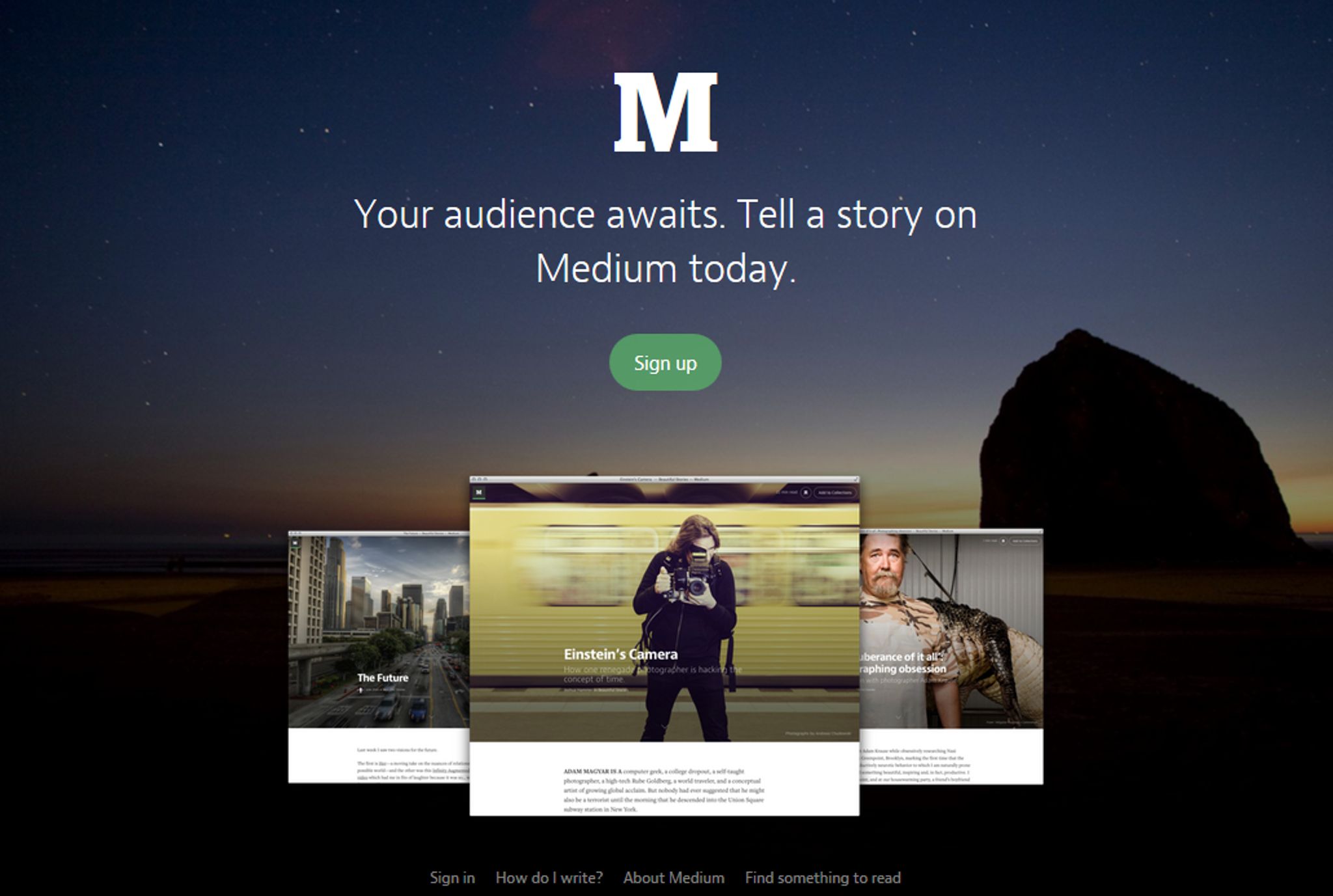
Lately, we've been seeing a shift towards simple, responsive, minimalist blogging platforms. More and more, people are looking for solutions that help them focus on their writing and offer distraction-free environments that enable them to do so quickly and effectively.
For years, WordPress has been the star of the show when it comes to blogging, but lately it seems to be developing into a more complex CMS than it was initially intended for when it was first released. Scores of plugins, themes and addons have, according to some, turned it into a more bloated solution than is necessary for the simple task of blogging.
Some of the differences you will find with these solutions in comparison to other blogging platforms are the editing interfaces and the reduction in features to focus on the primary goal of blogging; the writing. As opposed to more complicated editors, they tend to use Markdown for writing blog posts. Markdown is an easy to use text formatter that converts plain text into HTML and produces very readable content using plain text. You'll see what I mean when you try one of these blogging platforms. It's very easy to use.
For those who are finding it hard to find a blogging platform that suits their needs or are looking to start a new blog, this post will offer you some excellent alternatives to popular platforms like Blogger and WordPress. Here is our list of the best minimalist blogging platforms available.
Postach.io
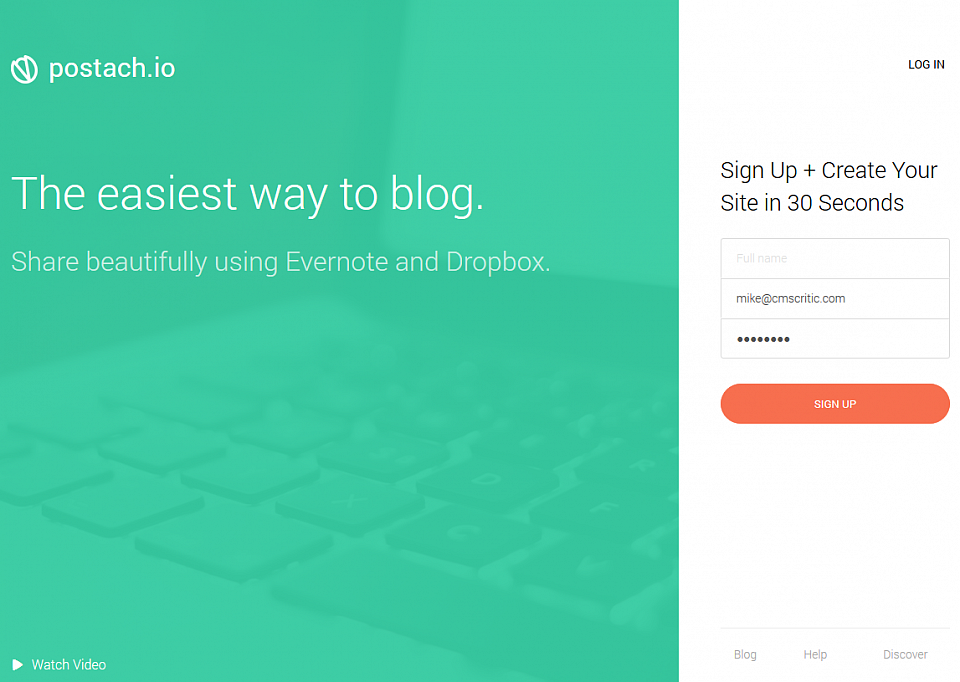
I had to put Postach.io first simply because it's my personal favorite and one that, in my opinion, offers the most unique approach to blogging. Postach.io lets you store your content in either Dropbox or Evernote or both. This lets you choose whichever interface suits you the most (Dropbox files obviously needing to be edited in a text editor and uploaded whereas Evernote has a built in text editor) and work on your content within.
Publishing a post with Evernote is as simple as connecting your account to Postach.io, telling it which notebook in Evernote will contain your posts and then simply writing in that notebook and using the tag “published” when you are done. This tells Postach.io to put the post up on your blog and that's all there is to it. To add images, simply attach them to the note and it will be inserted in your blog post instantly.
The nice part to using the Evernote connection for Postach.io is you can take advantage of the many awesome Evernote apps for mobile devices and tablets that already exist which makes blogging with it a true pleasure.
Postach.io also has perhaps the most features of any of the other platforms I've mentioned so far including:
- A number of pre-designed and attractive themes.
- The ability to easily embed tweets, vine videos, youtube videos, instragram photos, flickr photos, slideshares, about me pages and tons more.
- Disqus commenting
- Google Analytics integration
- You can even share your posts automatically on Facebook or Twitter simply by tagging them in Evernote or Dropbox (you can even customize the tag you use)
- A full integrated source code editing interface
While Postach.io is free, you can upgrade for $5 / month or $50 / year and get the ability to have multiple sites, multiple authors and a secure website.
Postach.io is a must see and I strongly recommend taking a look to see how amazing it is.
Price: Free
Medium
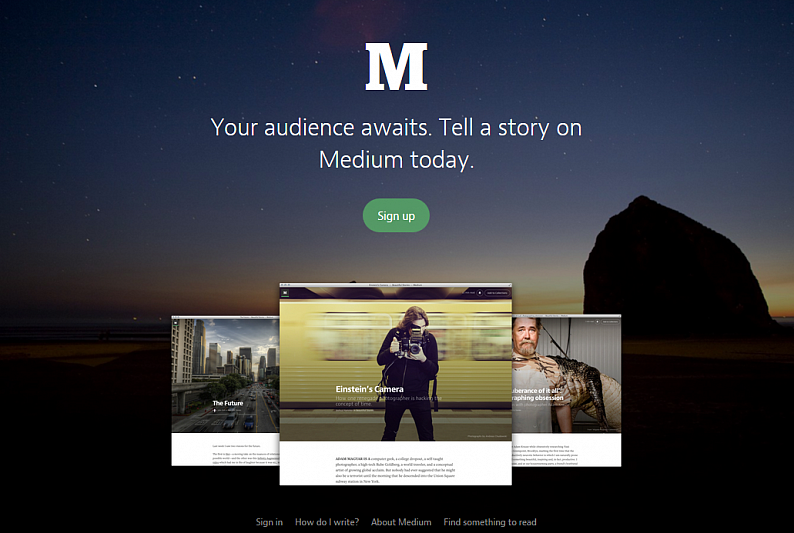
Medium is a very interesting and unique alternative. What's nice about it is that it is designed to help you find an audience and to help you write better content. With a very simple and easy to use interface, Medium is a pleasure to use and gets rid of distractions such as sidebars, widgets and plugins while focusing on allowing you to share your stories and quips with the world.
Rather than overwhelm you with formatting, Medium offers you just enough to do what you need to do and nothing more. This makes the writing process painless and so distraction free that you'll likely want to write more just so you can use the editor. It truly is a beautiful setup. Furthermore, you don't need to worry about whether your website on Medium is responsive. Everything scales to all devices so you will never need to worry about how it's going to look on your phone or tablet again.
It's also a collaborative tool that lets you share your drafts with others and collaborate with them to produce better content. You can even thank those who helped you proof read or add ideas to your content.
My favorite thing about Medium, however, is the way your content is handled once you hit publish:
We think great ideas can come from anywhere and should compete on their own merits. On Medium, you can contribute often or just once in a blue moon, without the commitment of a blog. And either way, you’re publishing into a thriving, pulsing network — not a standalone web site, which you alone are responsible for keeping alive.
Through a combination of algorithmic and editorial curation, posts on Medium get spread around based on interest and engagement. Some get hundreds of thousands of readers — and not because they were written by famous people. Medium is not about who you are or whom you know, but about what you have to say.
I've seen this in action on some of my own writings on Medium where people who I do not know have added comments and shared their thoughts with me. If you write great content, you have a great opportunity to find an audience on Medium.
Price: Free
Svblte

Svtle is similar in some aspects to Medium in that the platform uses Markdown for formatting content and is very distraction free. If you can't tell by the screenshot of the Svblte.com homepage above that this is a minimalist blogging platform, I'd be surprised.
Svblte has been designed in a way to let you dump your ideas into the dashboard and save them as inspiration for future work. It lets you write very distraction free content using an incredibly simple editor with minimal formatting required. It also offers some features such as custom domains and avatars for instance. You can also customize the accent colors of your blog but that's about it. The intention, like most of the others in this list, is to reduce the distractions caused by themes and plugins and to simply help you get your content out to the world.
Your content also has an opportunity to get picked up and spread throughout Svbtle in a similar manner as Medium although they don't give much for details on how this works so I'm not super familiar with the process for curation.
Price: $6 monthly
Ghost
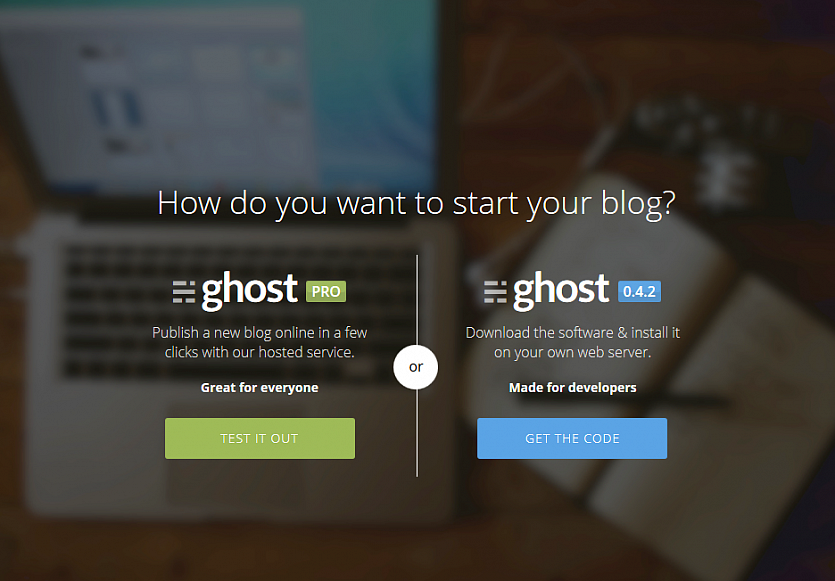
Ghost is quickly becoming a strong up and comer in the world of blogging and is following in the footsteps of WordPress in that it offers both a downloadable version of the platform to install on your own server or you can use their online blogging platform (similar to Medium, WordPress.com and others) and get up and running with no software to configure. The latter is a paid service, however, and costs typically would range between $5 / month and $80 / month depending on how much traffic and how many blogs you want to have. Pricing is pretty reasonable and you always have the option of downloading Ghost and installing it on your own server if you feel more comfortable managing the software yourself.
The writing interface that Ghost offers is unique from some of the others we've shared so far in that it offers you a split pane look where you write on the left and the right shows a live preview of the text as it's being formatted for comparison. See the screenshot below for an example:
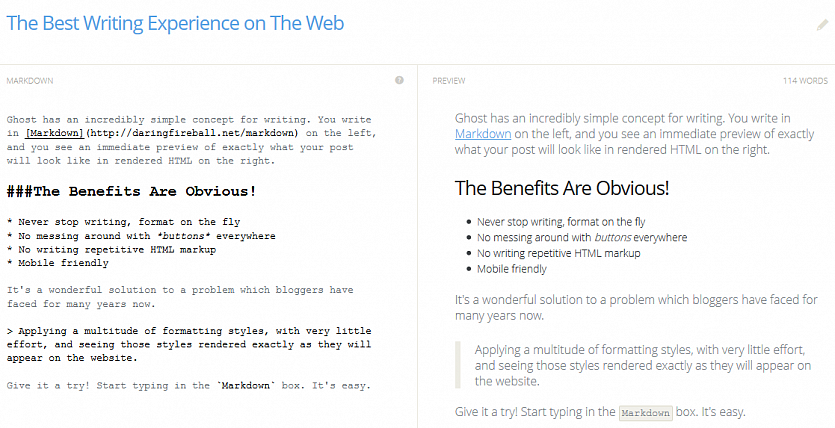
Some other differences between Ghost and platforms such as Medium and Svble is that it supports themes. My personal opinion is that themes can end up being a distraction for some people but if you are interested in them, there are already plenty of themes for Ghost available.
Price: Free (if downloaded) or $29-199 / month (if hosted)
Silvrback
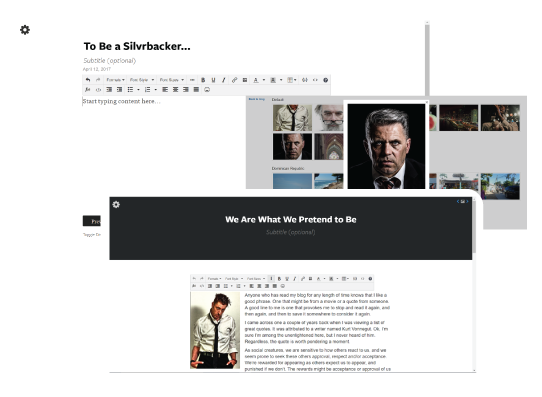 Silvrback is interesting in that its creator, Damian Sowers, aimed to fix the problems he saw with Medium and Svbtle by simply creating what he ideally wanted from a blogging platform for himself. He has now made this available at a reasonable cost of $29.99 / year in the form of Silvrback.
Silvrback is interesting in that its creator, Damian Sowers, aimed to fix the problems he saw with Medium and Svbtle by simply creating what he ideally wanted from a blogging platform for himself. He has now made this available at a reasonable cost of $29.99 / year in the form of Silvrback.
Here's how Damian describes his reasoning for creating Silvrback:
I built Silvrback because none of the existing blogging platforms satisfied me completely.
Medium is great for readers but it is bad for writers. Readers are steered away to other articles/authors after they are done reading your article. Moreover, the analytics of Medium are extremely basic and you have no idea how people found your article. You really shouldn't use Medium if you want to build any kind of brand with your writing.
Svbtle is closer to what I wanted out of my blogging platform. However, it is taking the elitism approach and heavily restricting its users. I actually just received an invite to Svbtle but I have grown tired of their UI and I'm wary of any blogging platform that doesn't charge for the service. As the saying goes, “If you aren't paying for something then you aren't the customer, you're the product being sold.”
Due to his lack of satisfaction with the other tools on the market, Damian created Silvrback with the following features:
- A clean and modern UI (front and back-end).
- Markdown powered and as simple as possible.
- Support for custom domains and external analytics.
- Hosted. People shouldn't spend any time configuring a server for a blog. Also, you shouldn't have to worry about traffic spikes crashing your server.
- The platform should have brand awareness in mind (e.g. provide a better way to show and consolidate a person's distributed accomplishments).
- Trustworthy. I don't want my efforts and content to be sold to advertisers.
- Hacker friendly. Nice syntax highlighting.
- Precise control over the journey of a new reader (direction of article discovery).
Silvrback was sold to Verde Places LLC, who currently own and run it now and continues to be updated regularly.
Pricing:
- Annual: US$34.99
- Quarterly: US$9.99
- Monthly: US$3.99
Write.as
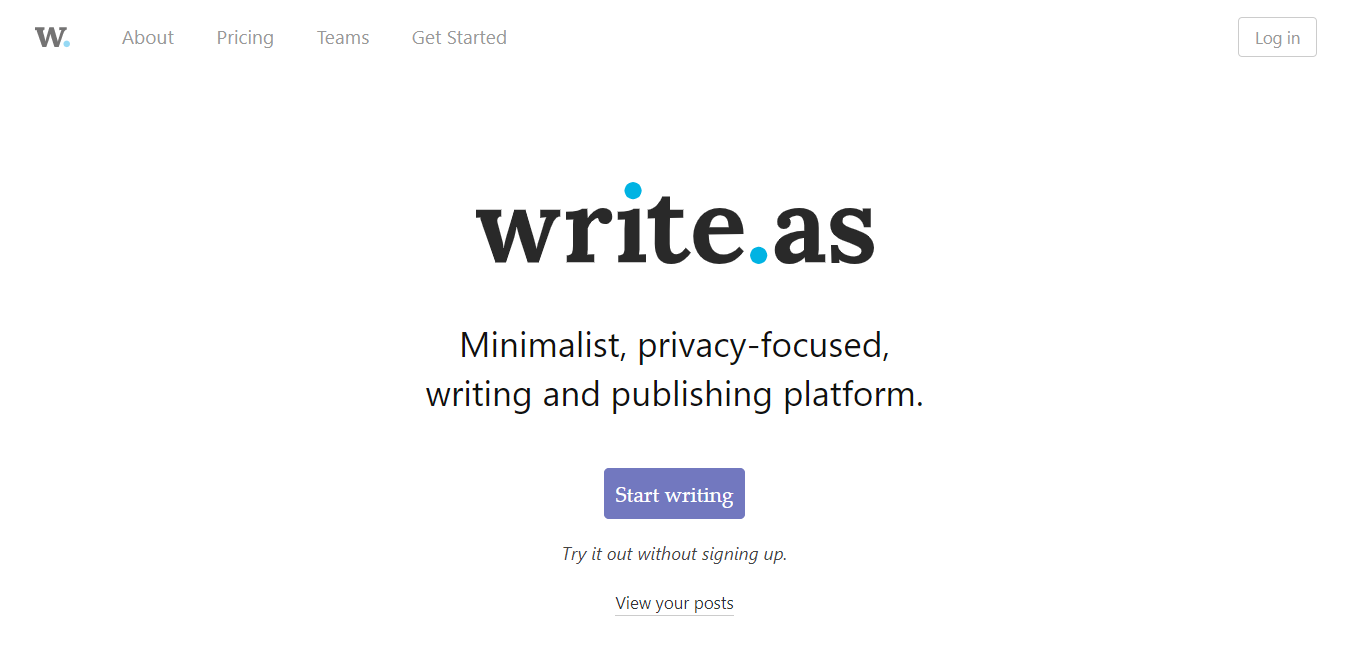
Write.as is a distraction-free publishing platform that is less about the social media aspect of writing (the likes and follows that we all inadvertently seek) and more about getting your thoughts down fast. The platform’s simplicity is refreshing, but not ideal for complex blogging, especially if you don’t know any code.
On the other hand, because Write.as is open source, technically-minded individuals can change it to suit their needs. Read our Write.as Review to learn more.
Price:
- Free
- $5 month
- $200 month
Authpad
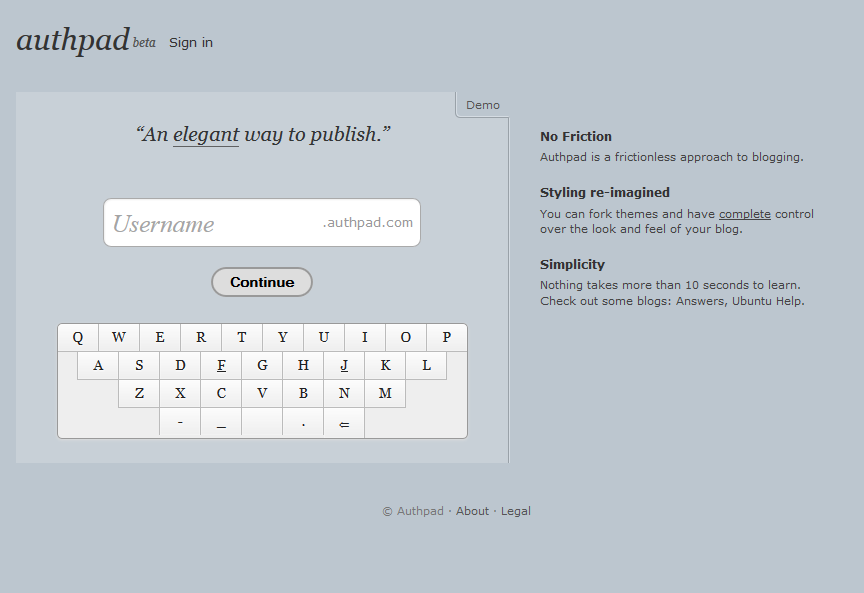
Authpad appeals to my inner coder for some reason. Perhaps it's because you can edit the styles directly from within the interface but if there's one thing that Authpad is, it's minimal. I would call this the blogging platform for pure minimalists. It's so fast it's ridiculous and, while the interface is very text heavy, it does the job its intended to do incredibly well.
Still in beta but with plenty of features including, as I mentioned earlier, the ability to directly edit forked styles from within the interface, this is sure to appeal to bloggers with a bit of a technical background as well as those looking for a very minimal experience.
There's not much else to say, Authpad is as basic as you can get and I strongly encourage you to check it out and see how simple blogging can truly be.
Price: Free
Pen.io
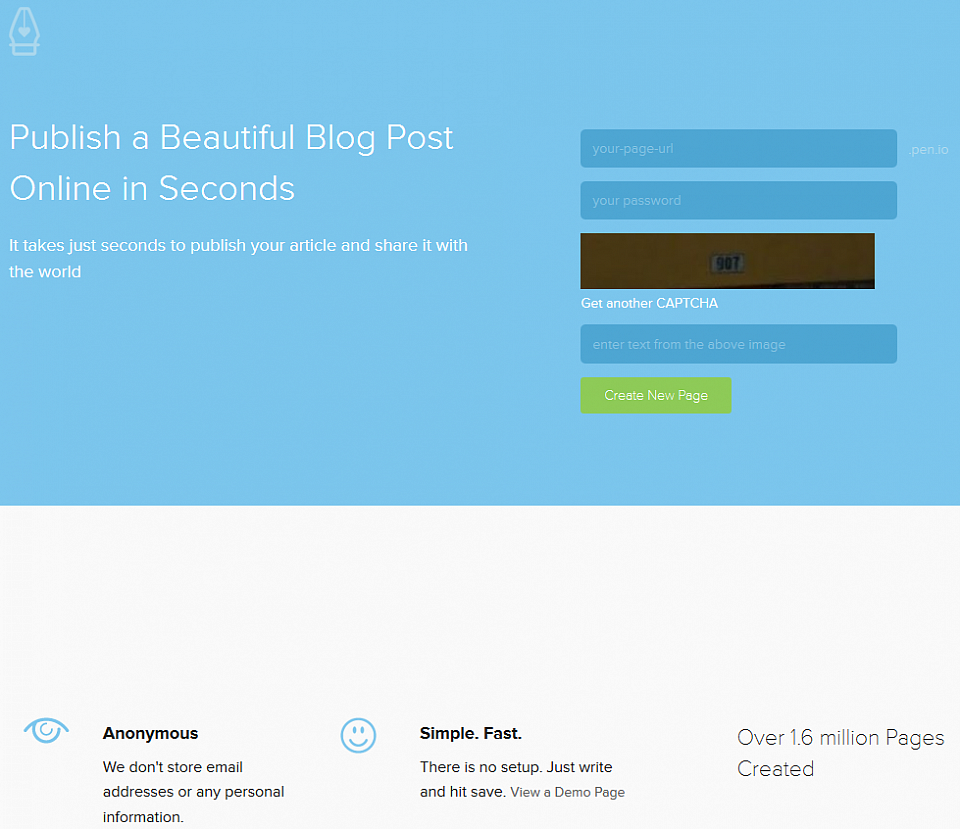
Pen.io is a bit different. You don't get your own website per say but rather, you create a page for your article. You sign up with a URL and a password with no other information, click to edit your title, click to edit your content and that's it. If you need to add images, simply drag and drop them into the page. If you need a multi-page post, simply insert the “:page” tag to do so. There's nothing complicated about it, there's no real blogging aspect to it and there's no way to get back to it other than to find it on Google or remember the page url.
This is unique for those who want to quickly pound something out or feel the need to write but don't want the complication of setting up a blog so if you need an outlet for your creativity, Pen.io is there. Don't expect to find any help or assistance, however as the website is as stark as the article creation process and there's no help system at all.
Price: Free
Posthaven
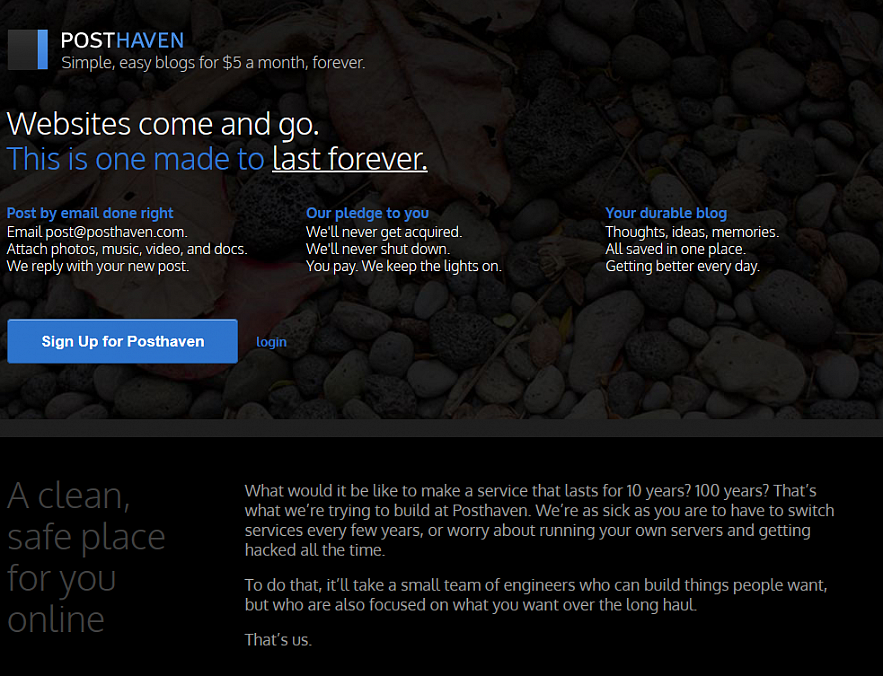
Posthaven was created by two of the founding members of Posterous, which was acquired by Twitter in 2012. After being “bummed” that it was shut down, they decided to start Posthaven and make it available forever to anyone who wants an easy to use blog platform. While the platform does charge a monthly fee, it offers a good set of features including:
- Post by email
- Post by web, with photos, music, video and documents
- Private sites with passwords
- Pages and links
- Autopost to Facebook and Twitter
- Image gallery upload and editing
- Commenting with automatic antispam
- Blog following with email notifications
- Multiple contributors per blog
Currently, the fee to use Posthaven is only $5 / month and the founders promise to only adjust to cover server costs and nothing more. The goal is to maintain the service for as long as possible so users can avoid having their services shutdown constantly thanks to acquisitions and the like. One thing I do like is that if you decide to stop paying, the content will not be lost, it will stay online but you won't be able to edit or add to it until you restart your subscription.
Price: $5 month
There you have it. Our list of Minimalist Blogging Platforms that let you focus on writing your content and getting it online in the easiest possible way with the least distracting interfaces.
Are you aware of one we missed? Please share it in the comments below and we'll expand this list accordingly. What are your experiences with these (or other) tools? Let us know in the comments below.